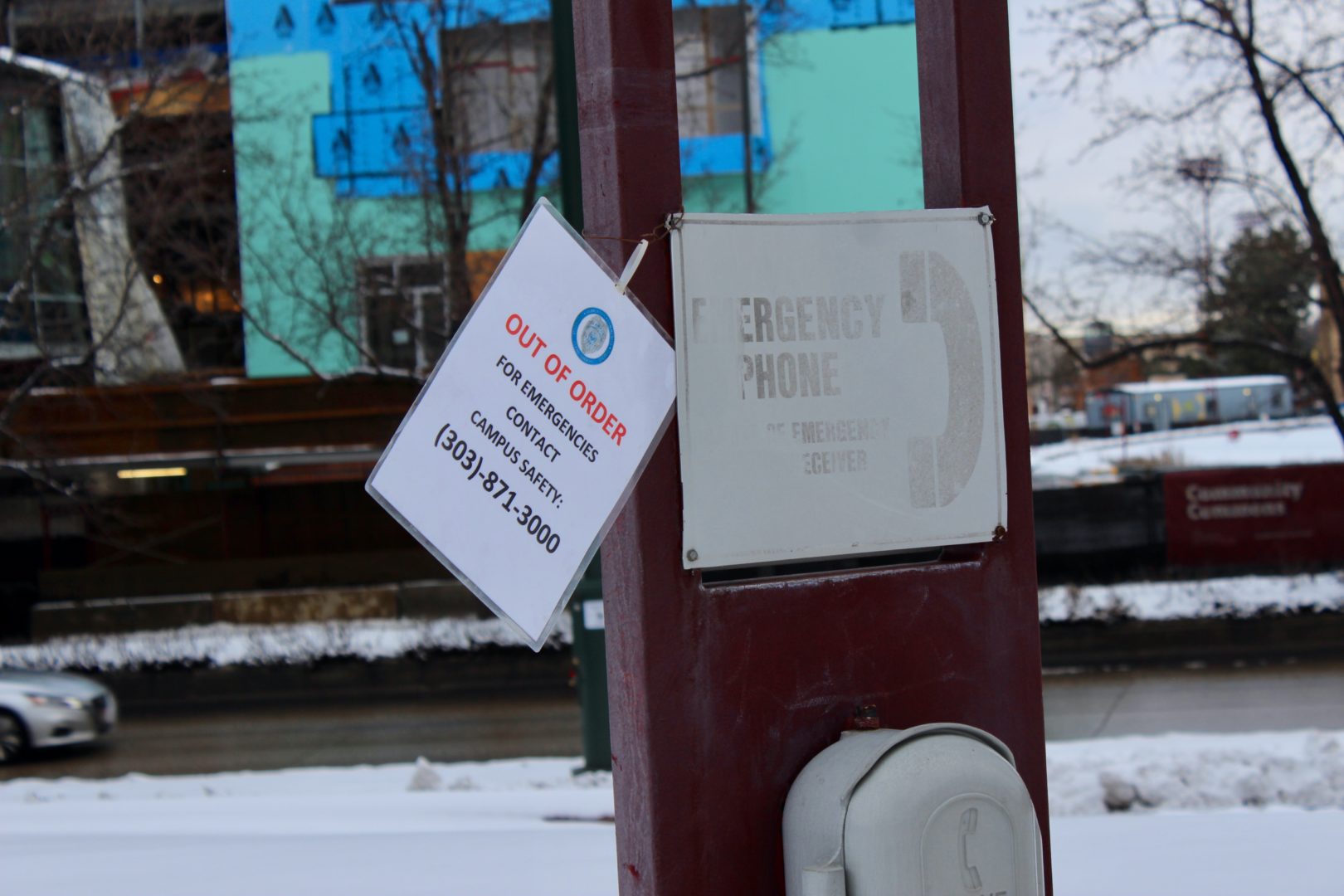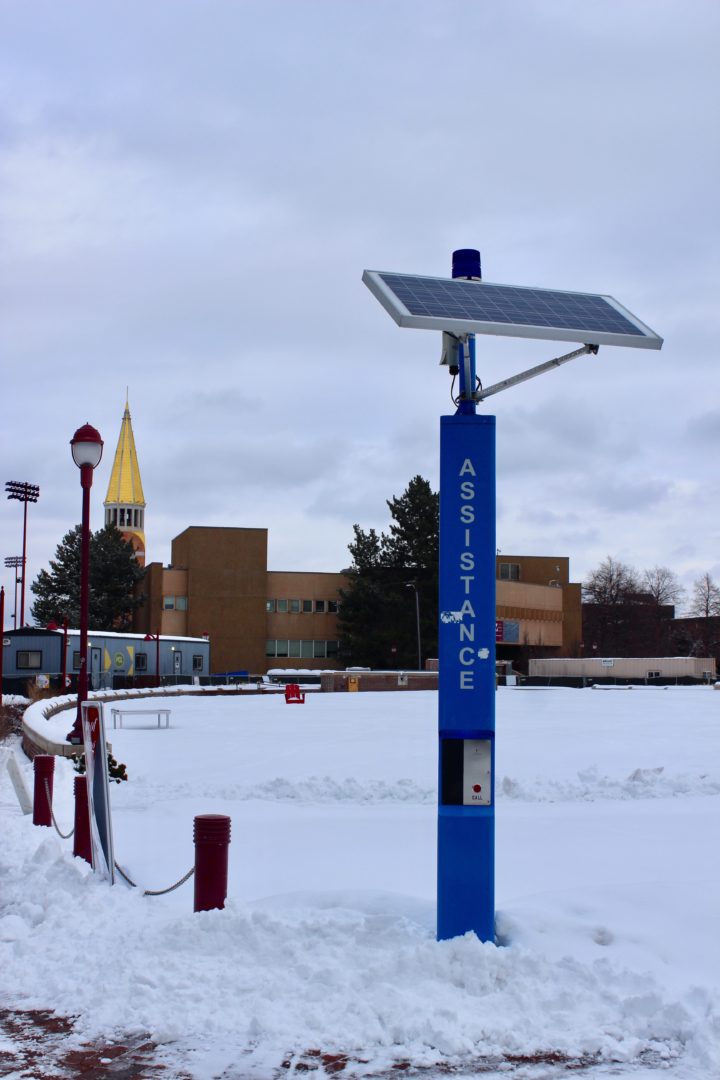Amid recent controversy, on-campus protests and student demands for better campus safety surrounding the @wecandubetter Instagram page, – the viral DU-based account highlighting the survivors of gender-based violence on campus – DU’s Department of Campus Safety is striving to improve campus life through recent developments in blue lights, camera technology and a personal safety wearable.
While there are currently 96 blue light emergency phones on campus, many of them are not functioning, not in use or have been decommissioned. After DU’s $143 million dollar campus-wide construction projects began in early 2019, including the new Community Commons, the Burwell Center for Career Achievement and the Dimond Family first-year residence hall, the wide-scale construction cut off power to the analog, hard-line phones that supply connection to several blue light phones without many students’ realization.
Currently, these phones are marked with signs indicating that they are not operating, but DU campus safety is in the final planning stages, and, in some cases, underway on the first steps of installing a brand new “assistance phones” system across campus. At the earliest, the department is hoping to finish the project by late August 2020 to replace the over 20-years-old systems on campus today.

This new system is not being branded as “emergency only;” rather, the phones are for assistance if someone is lost on campus, needs a campus safety escort or lost their phone and wants to put in a report.
“We want people to use these stations for anything,” stated Matt Ulrich, a support specialist for campus safety and one of the primary technicians of the blue light replacement project. “We’ll still answer it ‘What’s the location of your emergency,’ because we do want to give priority to a tower, but you can use it just because you need directions or you see something weird happening on campus and you want to alert us.”
In total, 29 new towers will be installed around campus along with 25 new garage phones already being replaced in many parking garages around campus. The number is significantly less than the existing 96 blue lights alone.
The reasoning for this exists in the surprising lack of phone calls that come through the blue lights. From January—December of 2019, 51 blue light calls were made, according to Campus Safety Community Resource Officer, Jon Andersen.
“Most of them [the blue light phone calls] are non-emergencies,” stated Andersen. “I can’t even recall an actual emergency coming from the blue light phones.”
With most severe cases, like in sexual assault or gender-based violence of any kind, blue light phones are not used and students instead usually directly call campus safety’s emergency phone number (303-871-3000).
“When I do presentations, I always recommend students putting that [phone number] right into their phone so they have quick access,” said Andersen. “Because if they take the blue light off, it’ll call into our dispatch center and we’ll send an officer out, but if there’s no one on the other line explaining what’s going on, they’ll [campus safety] still respond to that phone. But it’s nice when we can call a number directly and get that information.”
It is especially recommended that students have that emergency number in their phone under the current broken conditions and construction of the new assistance phones. While replacement is within the jurisdiction of facilities rather than campus safety, most broken or decommissioned phones will not be repaired due to the difficulty in ordering parts for the old system and from construction cutting the phone wires.
In addition, even though the blue lights are checked monthly, the phones cannot be judged as broken until these monthly checks.
“Since they [the existing blue lights] are all analog, you can’t really tell if one’s broken or not – you just have to physically go test it,” stated Ulrich. “Since these [new] ones are on the network, Campus Safety will get alerts as soon as they go down.”
There will be two types of new towers. The new assistance phones that will be similar to the existing blue lights are the wireless Talkaphone 600E model that uses cutting-edge Fluidmesh technology. In compliance with previous Chancellor Chopp’s DU Impact 2025 plan and its sustainability efforts, the towers will be solar paneled and built on an aluminum tower, known as an eco-tower. Additionally, the phones are fully ADA compliant; they will display a message saying “Calling” and “Help is on the way” after the call button is pressed for hearing-impaired people and will also have Braille on the talk box.

“A few will be replaced one-for-one, in the same location, but most are going in new locations,” said Ulrich of the new assistance phones. “It’s [the locations of new phones] based off of years of crime statistics or the best-lit paths or the ADA preferred paths where they clear snow. There’s been a lot of research into where the towers are going.”
However, these new towers will not provide additional lighting to campus as the current blue lights do due to their low-power functions. The towers will only have a low-lit LED light on top.
In addition, this project will also put five mass notification systems on top on certain towers around campus and two extra systems mounted to buildings. With four dialable speakers mounted at the top, these towers will have the ability to ring out alerts at all points across campus with the most severe threats like intense weather or active shooters. This is helpful for DU community members without their phones or who do not receive text alerts.
The emergency phones in parking lots are also seeing significant updates. Seeing similarly low-usage on these phones, even in the single digits, there will be 25 new phones instead of the existing 50.

New cameras may also be implemented on some of these new assistance towers, specifically on the ones by Centennial Halls to offer a way for campus safety to look up and down High Street in case of investigation purposes. DU currently has around 700 cameras that are used for crime mitigation purposes.
DU Campus Safety has been updating its technology on campus steadily for the past five years with the blue lights being the last analog system on campus left. According to Ulrich, the last analog camera was replaced in 2018; over 200 new cameras were placed in residence halls and all cameras on campus are now HD and less than five years old.
These cameras are monitored in the communications center of Campus Safety.
“We always have at least one person in there, but we staff up to three depending on the day or the event,” said Ulrich of the communication center.
Ulrich also mentioned the case last year of Christopher Finger—the man arrested for and charged with stealing women’s undergarments from the Ritchie Center—in representing how the cameras have been helping crime on campus.
“Brand new cameras that we just installed over the last year were integral in catching him, including new ones we just put at university place apartments,” stated Ulrich. “So if he tried this two years ago, we wouldn’t have caught him necessarily. If these upgrades lead to even just one more crime being solved, then they have paid for themselves in my opinion.”
Though DU was recently ranked as the 97th best school in the nation out of 400 from USNews.com, safety was not considered in the ranking process. According to Collegefactual.com, 557 incidents involving students on or around campus were reported by DU in 2018. The website, which analyzes data reports from thousands of major universities in the US, states, “Of the 2,795 colleges and universities that reported crime and safety data, 2,642 of them reported fewer incidents than this.”
Furthermore, according to the Annual Campus Security and Fire Safety report for 2019, some of the most severe crimes are still very much pervasive on campus.
Yet, some numbers have gone down significantly from the previous two years. In 2018, there were six reported cases of rape on campus and five in on-campus residential areas only. This is down significantly from 2017’s collective 13 cases and the 36 collective cases from only 2016.
However, stalking consistently reports similarly higher numbers and dating violence has increased since 2016. Burglary also persists, with nine cases in 2016, 20 cases in 2017 and 19 cases in 2018. In addition, drug and alcohol violations and referrals account for more than 300 cases each year.
DU’s Department of Campus Safety has 22 officers with two new hires being assimilated into the program soon. The officers work 365 days a year, 24/7.
There are always at least three officers on patrol, but on busier Friday and Saturday nights, there can be up to five. According to Andersen, Friday and Saturday nights are the time when most of the more severe incidents occur. At certain points, the campus safety officers can be understaffed as well.
“I think it’s [the number of officers] sufficient except on those busy nights,” said Andersen. “Sometimes you can have call after call and other nights it can just be completely dead and you have no calls at all. So yes and no—it’s kind of a catch-22. Even dispatch can have these long periods of time where you’re not doing anything and then you have all five lines lit up and the officers going call to call and they’re short. So right now we’re a little bit undermanned, but we just hired two new officers so that should hopefully fill the gaps.”
In addition, a new student-led group on campus is partnering with Hitachi technology to fill the gaps with personal safety applications that exist at many other college campuses. The ten-person student team is partnering with campus safety to invent a wearable safety bracelet that will be able to send out messages to friends and alerts to campus safety in any case of mild to severe distress, hoping to be tested in Spring 2020 and offered to students by next school year.
With all these new technological developments coming out of campus safety, the DU community can hope to see a decrease in crime and better campus safety in the upcoming year.
“It’s good to be able to explain what we do,” said Andersen. “A lot of people don’t understand some of the things that we do, but it’s good to ask and get the right answers. You know, we are a service to help protect the students and that’s our main objective. I stand by that—that’s very important to us.”
How to be informed and help with Campus Safety:
Respond to the short survey being emailed out soon from campus safety regarding blue lights, crime, and personal safety. The bigger the sample size, the better and more accurate picture of campus safety is put together that will better serve the DU community.
Make sure to follow campus safety social media accounts to be updated on all new developments: -Twitter: @DUCampussSafety, Facebook: @DUCampusSafety
Put the Campus Safety emergency phone number (303-871-3000) and non-emergency phone number (303-871-2334) into your contacts.
Look over the DU campus safety free classes.











